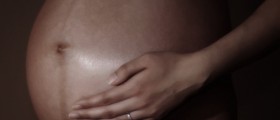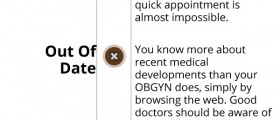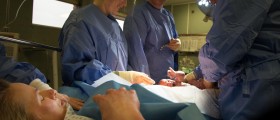There are many causes related to the situation where an expecting mother can be 40 weeks pregnant and still show no signs of labor. All of the crucial weeks of pregnancy are over, but the baby is not yet born, and the period of waiting is prolonged. This can be extremely unpleasant and depressing for a woman.
40 Weeks and Still no Labor
The expecting mothers usually get very worried if they find themselves 40 weeks pregnant, and no signs of labor are present. Their baby is very active, but there are no signs of Braxton-Hicks contractions or any other normal pre-delivery symptoms. However, women need to know that this is a perfectly normal scenario and there is nothing to worry about.

Symptoms of labor vary from woman to woman. Some women experience the first signs of expecting labor after the 38th week of pregnancy, but it is not rare to prolong the waiting up to the end of the 42nd week. Technically speaking, a mother is overdue only if her pregnancy goes past 42 weeks.
- Design: Multicentre, open label, randomised controlled superiority trial.
- Setting: 14 hospitals in Sweden, 2016-18.
- Participants: 2760 women with a low risk uncomplicated singleton pregnancy randomised (1:1) by the Swedish Pregnancy Register. 1381 women were assigned to the induction group and 1379 were assigned to the expectant management group.
- Interventions: Induction of labour at 41 weeks and expectant management and induction of labour at 42 weeks.
- The primary outcome was a composite perinatal outcome including one or more of stillbirth, neonatal mortality, Apgar score less than 7 at five minutes, pH less than 7.00 or metabolic acidosis (pH 12 mmol/L) in the umbilical artery, hypoxic ischaemic encephalopathy, intracranial haemorrhage, convulsions, meconium aspiration syndrome, mechanical ventilation within 72 hours, or obstetric brachial plexus injury. Primary analysis was by intention to treat.
- The study was stopped early owing to a significantly higher rate of perinatal mortality in the expectant management group. The composite primary perinatal outcome did not differ between the groups: 2.4% (33/1381) in the induction group and 2.2% (31/1379) in the expectant management group (relative risk 1.06, 95% confidence interval 0.65 to 1.73; P=0.90). No perinatal deaths occurred in the induction group but six (five stillbirths and one early neonatal death) occurred in the expectant management group (P=0.03). The proportion of caesarean delivery, instrumental vaginal delivery, or any major maternal morbidity did not differ between the groups.
If a woman is 40-42 weeks pregnant but does not experience cramping or contractions, it only means that her body is not yet ready for delivery. There are many ways to provoke labor earlier, but this can harm the baby. The baby may sometimes develop breading disorders because of incomplete lung development. It is far better to be just a little bit more patient until the body adapts to a normal and natural delivery.
Among all the signs of labor, women should know that there are three signs of labor, which are the most common. Mucus discharge is the first one. A mucous plug is present in the womb, and it is dislodged when the neck of the womb begins to open up. The discharge is liquid clear and slightly brown or pink. Water breaking is the second and it is the amniotic fluid that surrounds the baby. Once, when a woman gets into labor, the waters break and leak in small quantities or all at once.
Contractions are the third sign. Contractions are the tightening of the womb muscles that help to push the baby. At first, a woman may feel a mild and displeasing pain in the abdomen and this will progress to stronger, longer, and more severe pain. Back pain may also be present once when the baby’s weight is being shifted downward.
Effects after Pregnancy
Several postnatal complications are good to know to handle them easily in case they occur.
Nowadays, pregnancies generally end without complications. Labor can be vaginal or by Cesarean section, but the recovery can be followed by several postpartum complications. But, fortunately, these complications occur rarely.
A common postnatal complication is heavy bleeding. Heavy bleeding or hemorrhage is extreme blood loss after childbirth. Postpartum heavy bleeding can occur due to several factors. These factors include extended and complicated delivery, fragments of the placenta that stayed attached to the uterus, laceration of the uterus, an overdistended uterus that is a result of multiple gestations or a large fetus, and uterine fibroids that prevent the uterus from properly contracting. Rarely, the reason for postpartum hemorrhaging can be a genetic bleeding disorder.
In case that hemorrhage occurs as a result of over distended uterus or a uterus that doesn’t contract after complicated and prolonged delivery, the abdomen should be palpated to determine the size and position of the uterus. After that, uterine massage should be administered. The mother should position her feet above the heart and receive oxygen, as well as some medications. Breastfeeding is recommended by pediatrics since it promotes contractions of the uterus and can aid in restoring of the uterus to its original size.
Endometriosis
Rather common postpartum complication, endometriosis, represents uterine lining infection. Endometriosis occurs when the placenta separates from the uterus which then becomes susceptible to infections or if parts of the placenta remain inside the uterus. To prevent endometriosis the doctor must examine the placenta to see if it is in one piece. This examination is done to prevent hemorrhaging, too.
Symptoms of endometriosis involve increased body temperature, abdominal pain, and foul-smelling lochia. Treatment consists of antibiotics.
Episiotomy Site Infections
Infection of the episiotomy site is the one that can be easily prevented by proper hygiene. Symptoms of episiotomy site infections include wound tenderness and pain, abdominal pain, edema, problems with urination, high body temperature, and wound discharge.
Treatment includes antibiotics. To prevent this type of infection, women should regularly wash the perineal area, especially after using the toilet. Changing sanitary pads every four hours and avoiding using tampons should be done.
Conclusion
All in all, recovery after giving birth takes time. A woman must rest, eat healthy, and drink sufficient amounts of fluids. It is normal to feel uterine cramps because it is returning to their original size, but in case of persistent abdominal pain and fever, a woman must immediately consult the doctor. Also, in case vaginal discharge remains heavy and persistent 4 weeks after delivery a woman should seek advice from a doctor.
Future moms can occupy themselves with shopping for things they could need during and after delivery. However, if the pregnancy has passed the 42nd week and there is still no sign of labor, expecting mothers should consult a doctor or a midwife.
















Your thoughts on this
Loading...